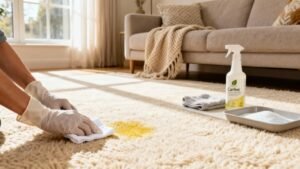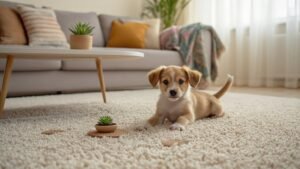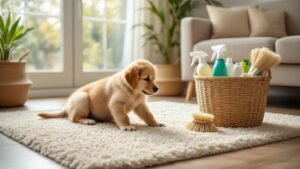I’ve found that removing dog urine from carpet padding requires acting fast and using the right approach. First, I blot up as much liquid as possible within 30 seconds using thick paper towels, then rinse with cool water. For the padding underneath, I use enzymatic cleaners like Nature’s Miracle that specifically break down uric acid – the real culprit behind persistent odors. I let these sit for 15 minutes before extracting with a shop vac. If you’re dealing with multiple accidents or older stains, well, the contamination might be too extensive for restoration. Keep exploring to discover when replacement becomes your best option.
Table of Contents
ToggleWhy Dog Urine Penetrates Deep Into Carpet Padding
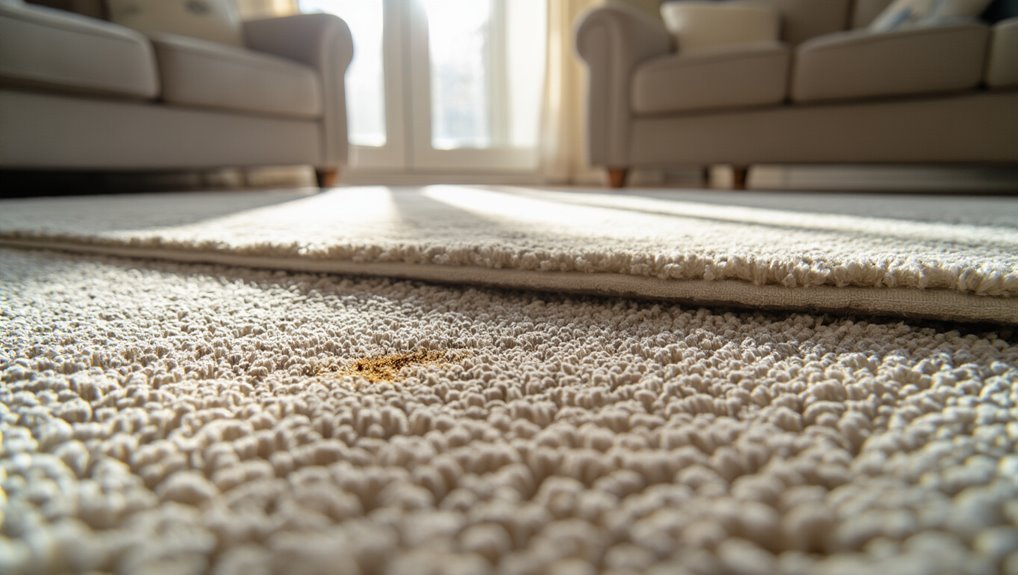
Why does dog urine seem to vanish from the surface only to haunt you with that persistent smell weeks later?
Well, it’s actually quite simple—and frustrating.
When your dog has an accident, carpet fibers absorb that urine incredibly quickly if you don’t clean it immediately.
The liquid then wicks downward like a sponge, especially in older carpets without leak-proof backing.
Here’s the real kicker: that visible stain you see?
It’s probably only showing you about 10-20% of the actual damage.
Untreated dog urine spreads beneath the surface, creating an area 5 to 10 times larger than what’s visible.
The carpet padding’s porous nature traps this liquid, making it nearly impossible for odor-causing compounds to evaporate naturally.
Immediate Steps to Take After a Fresh Accident
The first 30 seconds after you discover that fresh puddle on your carpet—well, they’re absolutely critical.
I can’t stress this enough: you need to soak up as much liquid as possible before it penetrates deeper.
Grab those paper towels and create a thick layer over the entire stain. Don’t scrub—just press down firmly and stand on them for several minutes.
This prevents pet urine stains from spreading and reduces those stubborn urine odors later.
After blotting, rinse with cool water and blot again.
Trust me, catching new stains early makes all the difference.
Handle accidents as soon as possible, and you’ll save yourself hours of work dealing with embedded odors and stains.
Effective Products for Breaking Down Urine in Padding
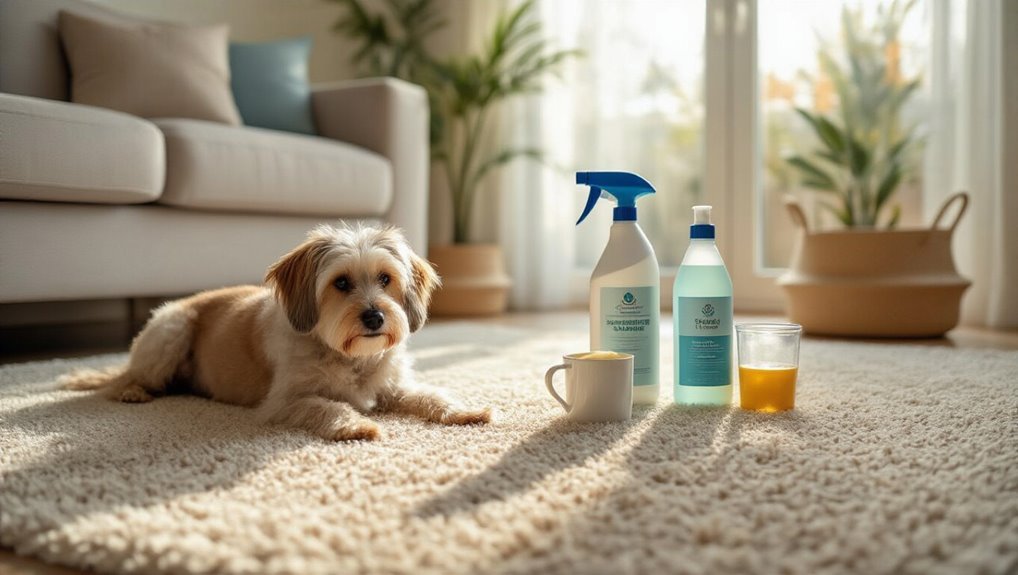
When that urine has already soaked deep into your carpet padding, you’ll need something much stronger than basic cleaning solutions—and honestly, this is where enzymatic cleaners become your best friend.
These specialized products actually break down the urine proteins that create those persistent pet odors.
Here are my top picks for tackling stubborn urine spots:
- Nature’s Miracle Urine Destroyer – This Pet Odor Neutralizer specifically targets uric acid residues in padding
- Hydrocide solution – Requires you to sit for 15 minutes, then extract with a shop vac
- Out! PetCare odor remover – Uses bacterial enzymes for significant results within 24 hours
- BISSELL carpet cleaner formulas – Combines hydrogen peroxide with probiotics for enhanced odor and stain breakdown
Deep Cleaning Methods for Saturated Padding
Once your carpet padding has reached that point of complete saturation—you know, where it’s basically turned into a soggy, smelly mess—you’re looking at a pretty intensive deep cleaning process that’s honestly going to test your patience.
I think your best bet is using a carpet cleaning machine with pet-specific formulas containing hydrogen peroxide.
You’ll need to extract and repeat this process maybe 2-3 times on stubborn spots to really remove those persistent odors and stains.
Here’s what I’ve learned: avoid steam cleaning completely.
It’ll actually bond that urine scent permanently into the fibers. Instead, stick with cold water extraction methods when tackling any pet stain.
The cleaner needs time to work, so don’t rush it.
When to Consider Padding Replacement vs. Restoration
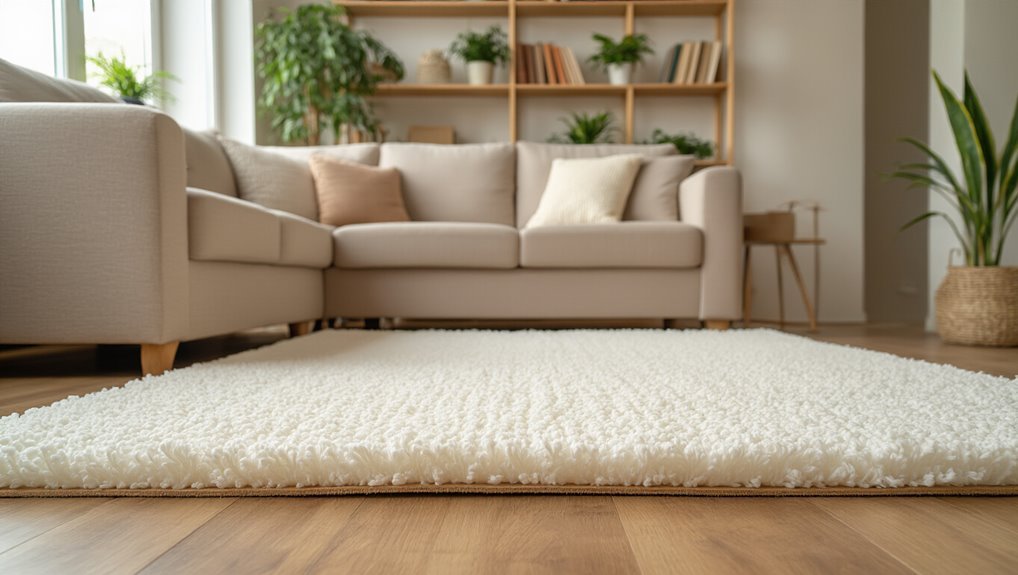
How do you know if it’s worth trying to save your padding or if you should just bite the bullet and replace it entirely?
I’ve found that this decision really comes down to four key factors that’ll determine whether cleaning can actually eliminate those stubborn carpet smells or if they’ll just stick around no matter what you do.
Here’s what I consider when deciding between restoration and replacement:
- Extent of contamination – If new and old pet accidents have soaked through multiple times, it’s probably time to remove and replace rather than keep cleaning
- Age of the pet mess – Recent incidents respond better to restoration attempts
- Padding type – Materials without moisture barriers often need replacement to stop your dog from peeing in the same spot
- Previous cleaning attempts – If odors persist after thorough cleaning, replace the carpet padding entirely
Preventing Future Urine Damage to Your Carpet System
After dealing with contaminated padding – whether you’ve cleaned it or replaced it entirely – I’ve learned that the real game-changer is stopping future accidents before they happen.
I think the best approach combines protective treatments with smart pet management.
First, I spray Scotchgard on my carpet fibers to create a barrier against spills and pet accidents.
When accidents do occur, I immediately grab my spray bottle filled with white vinegar solution to neutralize odors before they set.
Baking soda works wonders too – I sprinkle it generously and let it absorb moisture overnight.
Make sure you’re monitoring your pet’s behavior for warning signs.
Whether it’s cat urine smell or dog accidents, early intervention prevents that stubborn odor from penetrating deep.
I’ve found that consistent supervision really helps remove pet-related stress from carpet maintenance.
Frequently Asked Questions
How to Get Dog Pee Out of Carpet After It Has Dried?
I’ll use DriedStainMethods with enzymatic cleaners for OdorElimination, applying CarpetRestoration techniques like blacklight detection. These SurfaceTechniques guarantee thorough treatment, addressing SafetyConcerns while implementing PreventiveMeasures for lasting results.
What Draws Urine Out of Carpet?
Like magnets pulling metal, absorbent agents and enzyme formulas draw urine from carpet fibers. I recommend blotting tools, chemical solvents, and pH neutralizers that act as urine attractors, extracting stubborn odors effectively.
How to Clean Pee Out of Foam Pad?
I’ll blot the foam pad immediately, apply enzyme cleaner for natural urine treatment, rinse thoroughly, then use DIY odor neutralizer solutions for stain removal and preventive maintenance before complete drying.
Is There a Way to Clean Carpet Padding?
I’ll guide you through padding cleaning using deep scrubbing with enzymatic cleaners, vacuum methods for extraction, steam techniques for sanitization, and proper odor prevention strategies that include mold control and allergy management.

